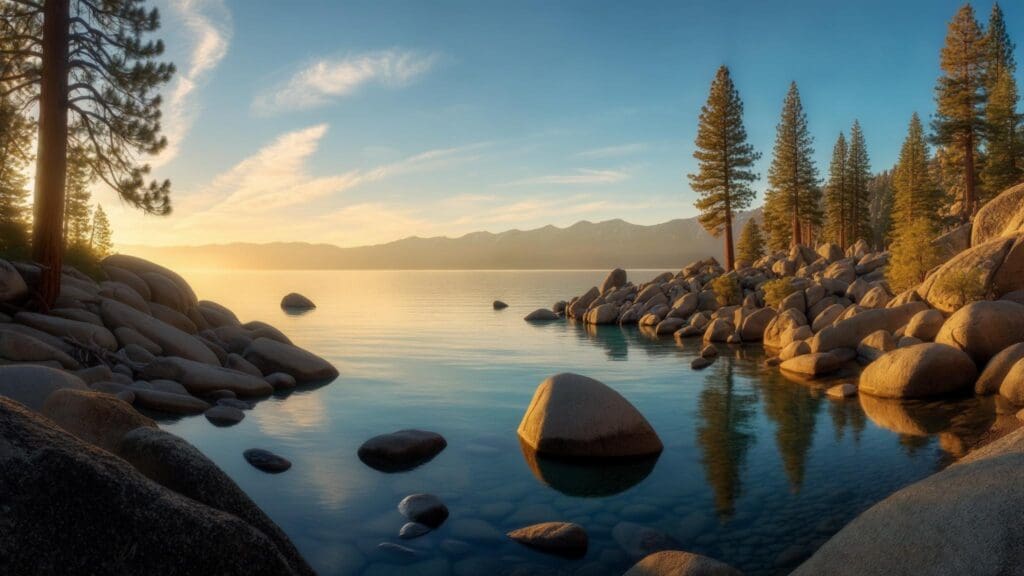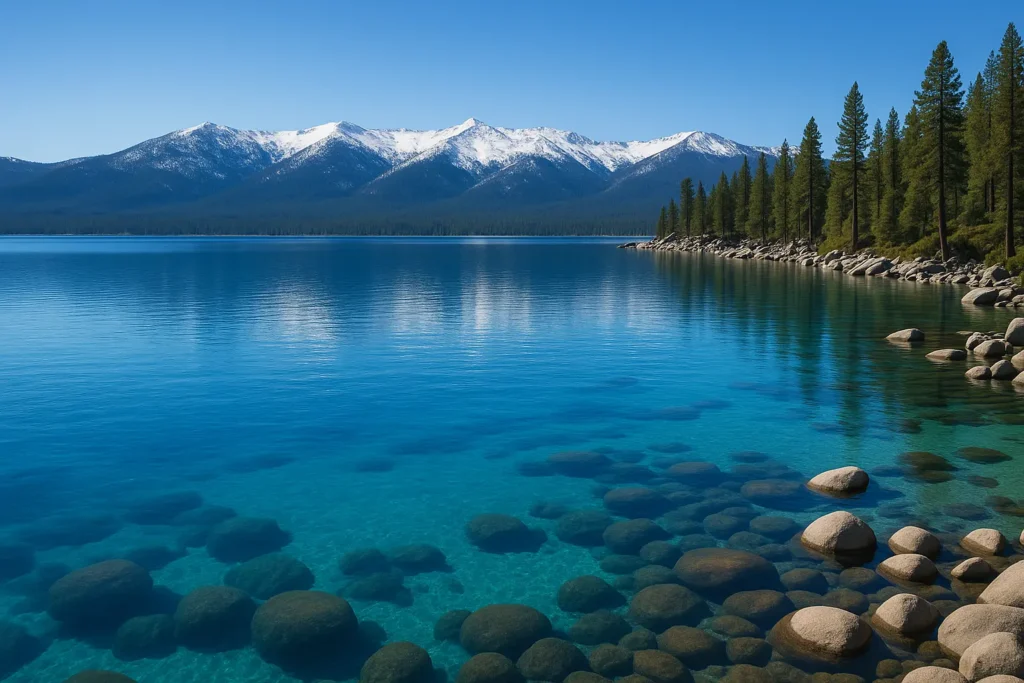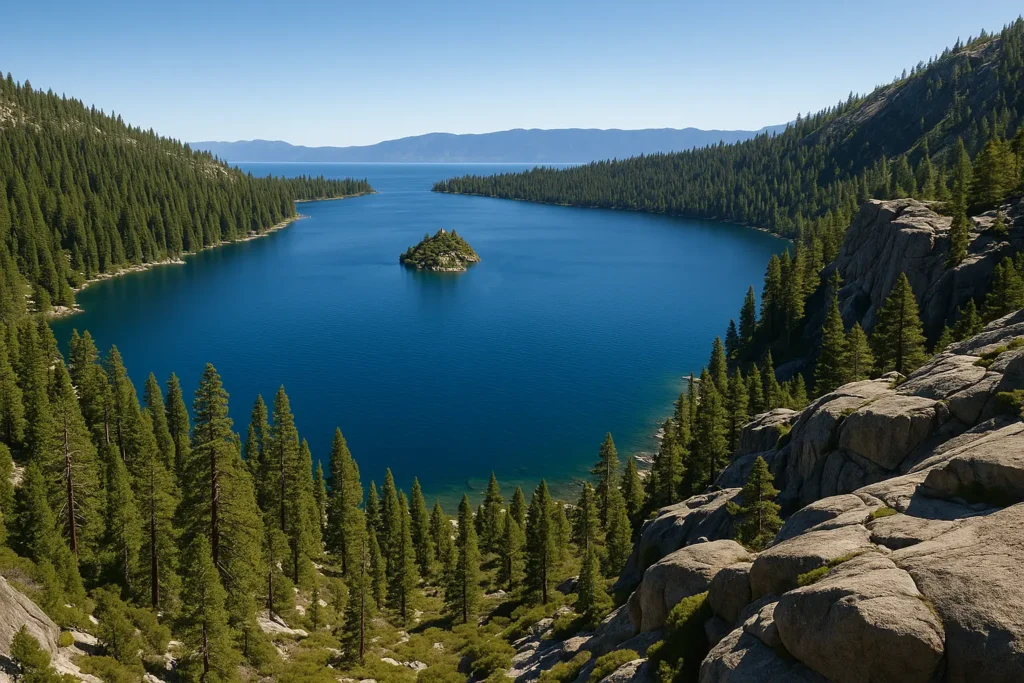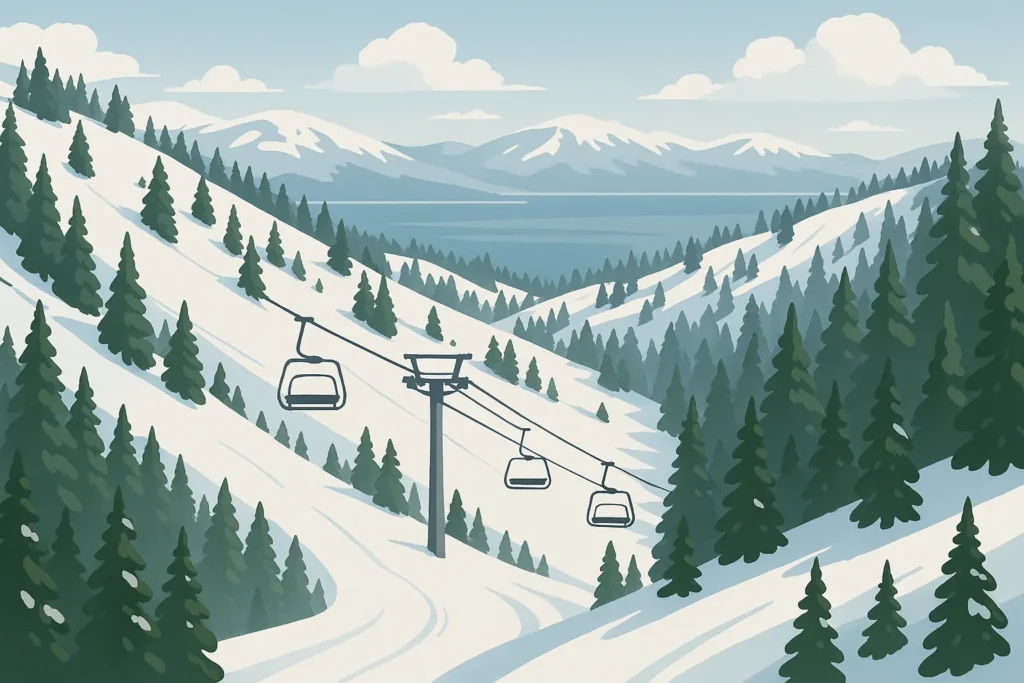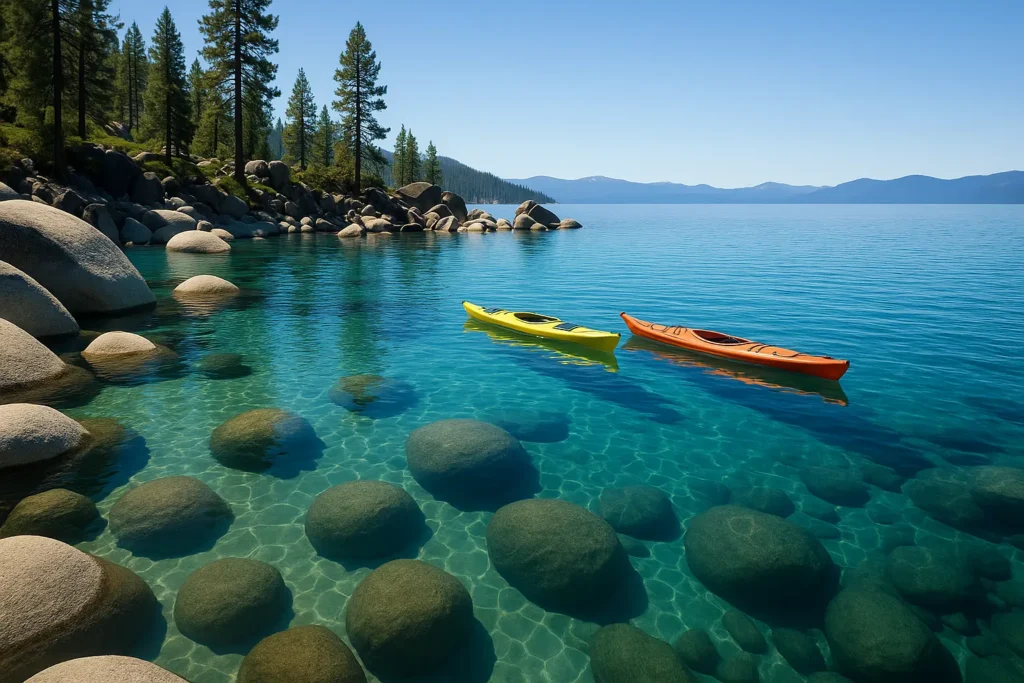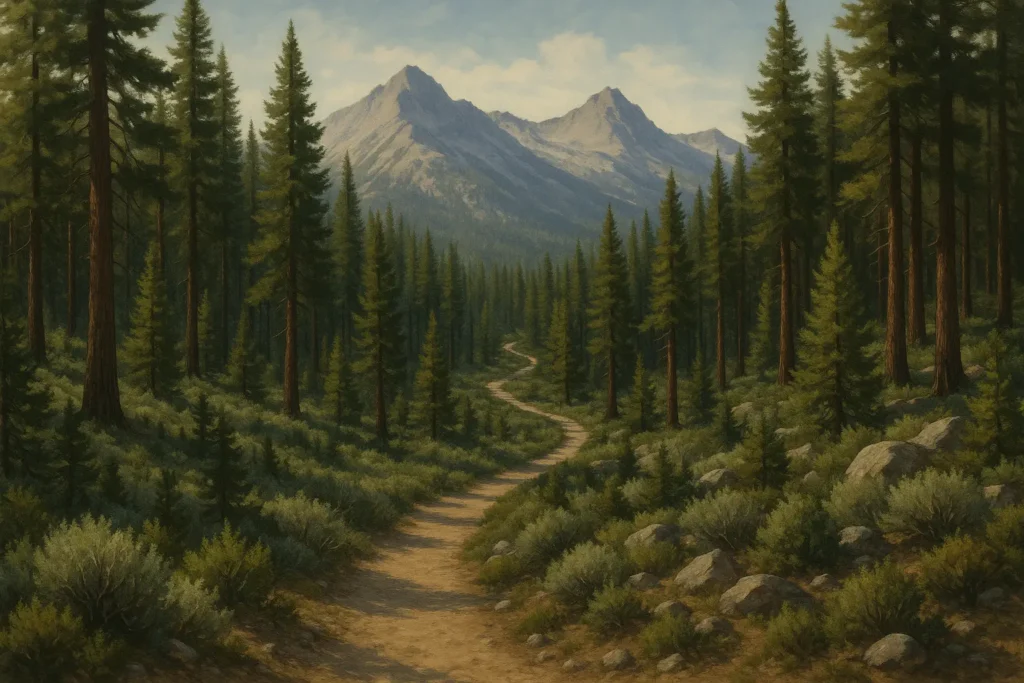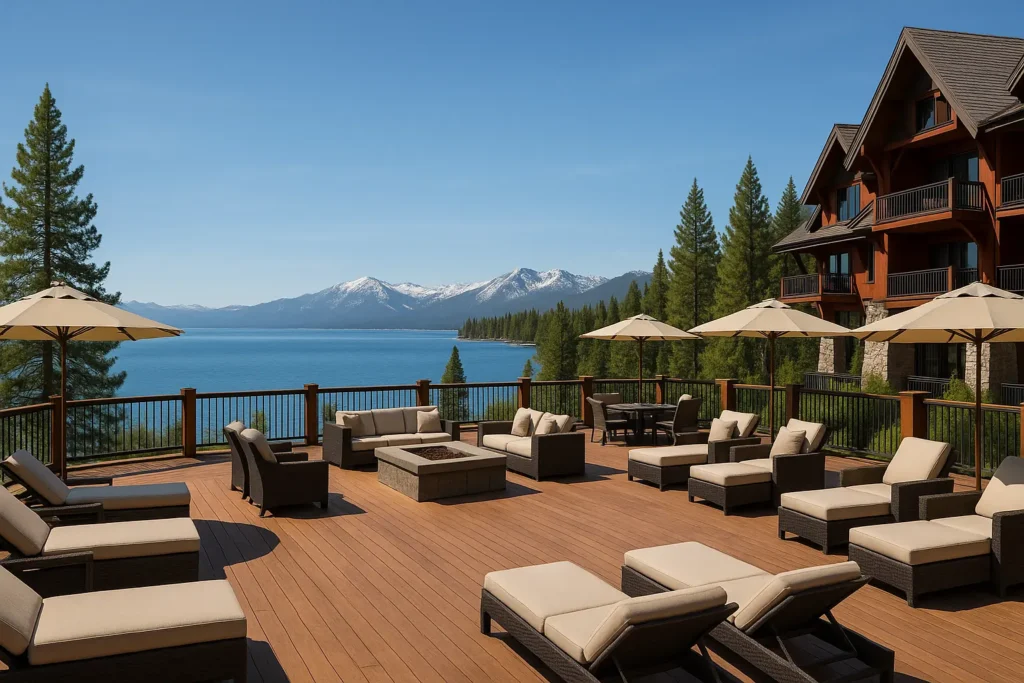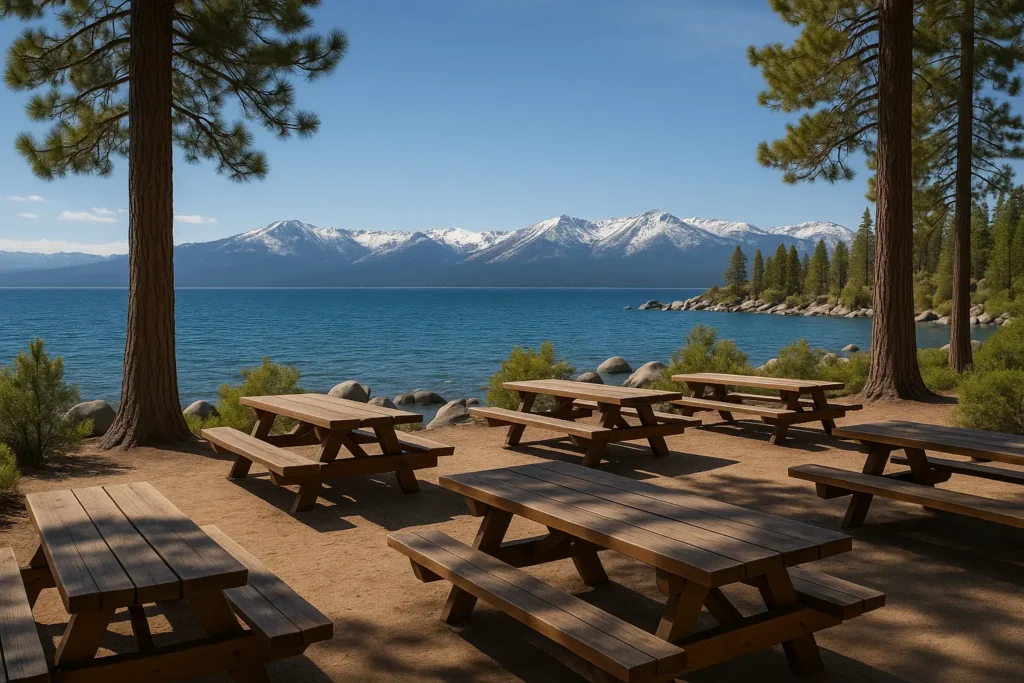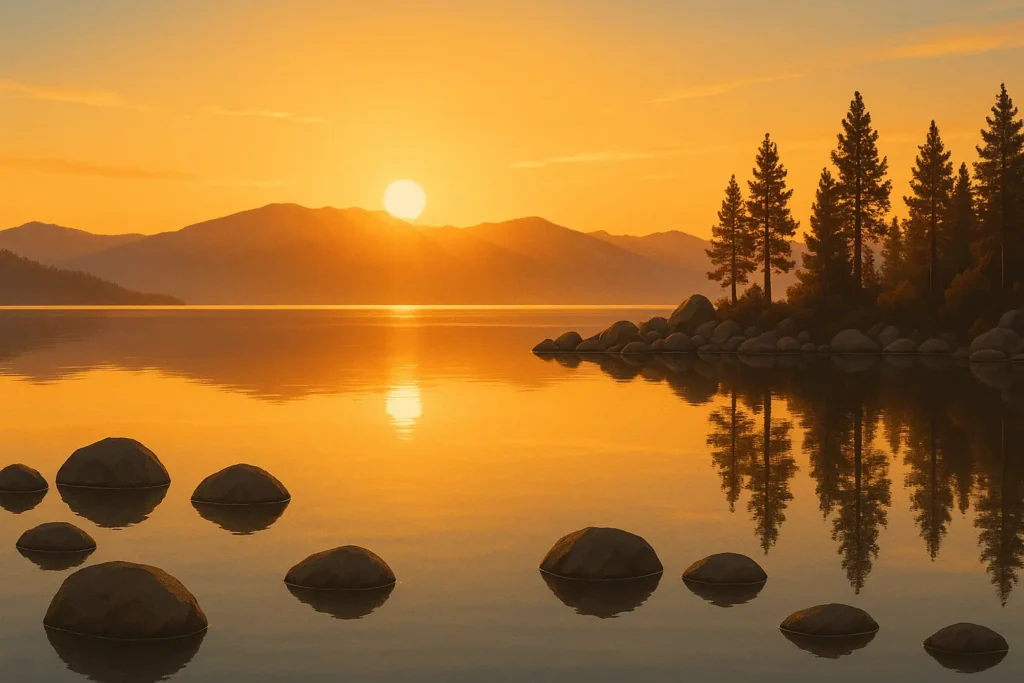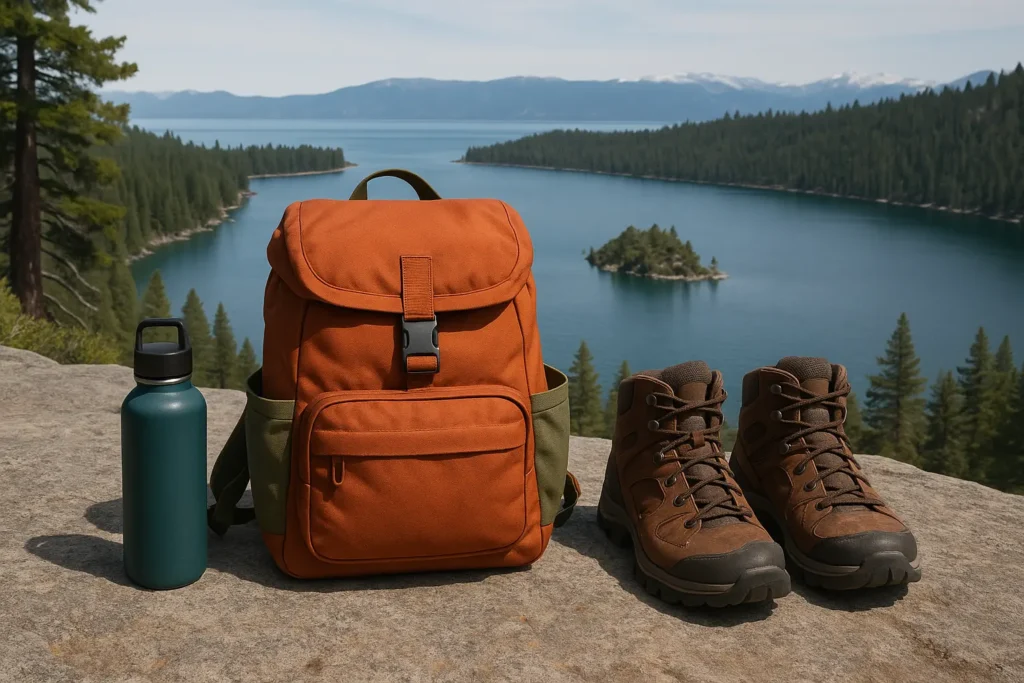Okay, so like 15 million people visit Lake Tahoe every year. That’s… a lot of people fighting for parking spots. I remember my first glimpse of that impossibly blue water surrounded by snow-capped peaks – it felt surreal, almost too perfect to be real. That moment sparked my obsession with crafting the perfect Tahoe experience, and after countless trips (and plenty of “learning experiences”), I’ve figured out there’s no single “right” way to tackle this natural wonder.
Create your perfect Lake Tahoe itinerary in minutes with our Vacation Planner — it’s fast, flexible, and stress-free.
Quick Resources:
-
Plan your mountain getaway with our Vacation Planner
-
Explore even more tools to simplify your planning with All Wedding Tools
TL;DR
- Duration matters: 3-day trips require serious focus while 7+ days let you actually breathe and explore without feeling like you’re on a game show
- Seasonal timing changes everything – summer means water fun but crowds and your wallet crying, winter brings epic skiing but terrifying mountain driving
- Budget ranges from $40/day camping (if you remember to pack everything) to $800+/day luxury resort life
- Get to popular spots before 9 AM or you’ll be taking selfies next to “LOT FULL” signs
- That drive around the whole lake? Yeah, it’s gonna take way longer than Google Maps says because you’ll stop every 10 minutes for photos
- Pick your home base based on what you actually want to do – North Shore for pristine nature, South Shore for nightlife and slot machines
- Group trips require designating one decision-maker or you’ll spend your vacation debating lunch spots
Planning Your Perfect Lake Tahoe Adventure
Look, before you dive into these 25 itineraries, you need to get real about what actually shapes your Lake Tahoe experience. Your timing, how long you’ve got, what you can afford, what you actually enjoy doing, who you’re traveling with, and where you crash at night – all of this stuff determines which itinerary won’t leave you exhausted and broke.
Simplify your trip planning and stay organized with our Vacation Planner.
Summer brings warm weather and water activities but also peak crowds and prices that’ll make you question your life choices. Winter offers world-class skiing with weather that can trap you in your hotel room for days. Your budget can range from camping at $35/night (and discovering your “waterproof” tent is more like water-resistant-ish) to luxury resorts at $800+/night where you better love that lake view because you’ll be eating ramen for a month after.
Seasonal Timing Changes Everything
Weather at Lake Tahoe creates four totally different experiences throughout the year. Summer (June-September) delivers perfect swimming and hiking weather, but you’ll share these experiences with everyone and their cousin while paying premium prices for everything from gas to granola bars.
Winter transforms the place into a snow sports paradise from December through March, though mountain driving becomes an extreme sport. I once watched a BMW slide backwards down a hill because the driver thought they were too cool for chains. Don’t be that person.
Spring and fall are honestly the sweet spot for many travelers. You get decent weather, way fewer crowds, and your credit card won’t hate you as much. April through May brings wildflower blooms, while September through November gives you those Instagram-worthy aspen colors.
| Season | Temperature Range | Crowd Level | Budget Impact | Best Activities |
|---|---|---|---|---|
| Summer (Jun-Sep) | 70-85°F days, 40-50°F nights | Absolutely nuts | Your wallet crying | Swimming, hiking, water sports |
| Fall (Sep-Nov) | 50-70°F days, 30-40°F nights | Actually manageable | Pretty reasonable | Photography, hiking, scenic drives |
| Winter (Dec-Mar) | 30-45°F days, 15-25°F nights | Ski crowds | Expensive for skiing | Skiing, snowshoeing, hot springs |
| Spring (Mar-May) | 45-65°F days, 25-35°F nights | Blissfully quiet | Best deals around | Wildflowers, moderate hiking |
Creating the perfect lake tahoe itinerary starts with understanding these seasonal mood swings, because they impact everything from whether you can even get a hotel room to if the restaurant you’ve been dreaming about is randomly closed because the owner decided to go fishing.
Avoid last-minute surprises and map out your seasonal plans using the Vacation Planner.
Duration Determines Sanity vs. FOMO
How long you’ve got basically determines whether you’re doing a greatest hits sprint or actually getting to chill and explore. A 3-day Lake Tahoe adventure means you’re gonna be hustling – think of it as Tahoe’s greatest hits on fast-forward. Great for first-timers who want to check all the boxes, exhausting for anyone who actually wants to relax.
Extended 7-10 day stays are where the magic happens. You’ve got time to explore all the shores, have backup days when weather goes sideways (and it will), and discover those random spots that end up being your favorite memories. Plus, you can actually recover from that altitude adjustment headache.
Budget Reality Check
Lake Tahoe works with every budget, but let’s be honest about what that actually means. Ultra-budget camping ($35-45/night) is awesome until it rains and you realize your gear situation is… optimistic. But hey, you’ll have authentic outdoor experiences and stories about the time you cooked mac and cheese on a camp stove in the rain.
Mid-range budgets ($200-300/day per person) mean you can eat out without checking your bank balance first and stay somewhere that doesn’t require bringing your own sheets. You’re not ordering the lobster, but you’re not surviving on trail mix either.
Luxury experiences ($500+/day per person) are amazing – spa treatments, gourmet meals, someone else carrying your luggage. Just remember you’ll be living on ramen afterwards, but sometimes that’s totally worth it.
Activity Preferences Should Drive Your Location
Here’s the thing – where you stay matters way more than most people realize. Love hiking and want to commune with nature? North Shore’s your jam with pristine wilderness and trails that’ll humble you. Want to party and maybe lose some money at blackjack? South Shore has casinos, restaurants, and nightlife.
Water sports enthusiasts should camp out near Sand Harbor and Emerald Bay. Photography nerds need flexibility to chase that golden hour light (which means getting up way earlier than you want to). The 72-mile loop takes forever to drive, so pick your base camp wisely.
When planning your lake tahoe itinerary, think about what you actually enjoy doing, not what looks good on Instagram. Trust me, hiking 10 miles for a photo you’ll never look at again isn’t worth the blisters.
Duration-Based Itineraries
Look, how long you’ve got basically determines whether you’re sprinting through the highlights or actually getting to breathe and discover stuff. Shorter trips mean accepting you’ll miss things – and that’s okay! Longer stays let you have those spontaneous moments that often become the best parts of your trip.
Design your ideal Lake Tahoe schedule with the Vacation Planner — perfect for custom itineraries and time balancing.
The key is being realistic about what you can actually accomplish without needing a vacation from your vacation.
1. Lake Tahoe 3-Day Classic Highlights
This is Tahoe’s greatest hits on speed dial – perfect for first-timers who want to see why everyone’s obsessed with this place. Day one is all about South Shore’s crown jewel, Emerald Bay, where you’ll take that postcard photo everyone expects from Tahoe. Then you’ll hike down to Vikingsholm Castle and immediately regret not bringing more water for the climb back up.
Day two shifts to North Shore’s crystal-clear waters at Sand Harbor. Pro tip I learned the hard way: get there before 9 AM or you’ll be circling the parking lot like a vulture. The afternoon brings a taste of the famous Tahoe Rim Trail, which will remind you that you live at sea level and this is definitely not sea level.
Your final day explores West Shore’s chill vibes with the Rubicon Trail and that famous lighthouse (which honestly looks more like a fancy outhouse, but the views are still Instagram-worthy).
This lake tahoe 3 day itinerary hits all the must-sees without completely destroying you, though you’ll definitely want to come back for round two.
Sarah’s 3-Day Reality Check: “We got to Tahoe Friday night and immediately drove to Emerald Bay for sunset photos – totally worth the detour. Saturday morning we hit Vikingsholm Castle at 9 AM and had the place almost to ourselves. The Eagle Falls hike was perfect for our skill level, though I definitely underestimated how winded I’d get at altitude. Sunday at Sand Harbor was magical once we finally found parking. We squeezed in a short Tahoe Rim Trail walk before heading home, feeling like we’d seen the highlights without being completely wiped out.”
2. Extended 7-Day Complete Experience
A week at Tahoe is where things get really good. You’ve got time to thoroughly explore each shore without feeling like you’re on a scavenger hunt. Spend your first couple days getting oriented in South Shore – Emerald Bay, Vikingsholm, maybe some shopping if that’s your thing.
Days three and four, head north for the wilderness experience. Longer hikes, multiple beaches, maybe rent a kayak and actually figure out how to use it without falling in. The middle portion focuses on West Shore luxury and those scenic drives that make you understand why people move here.
Your final days can be flexible – repeat favorite spots, try that restaurant everyone recommended, or just sit by the lake and read a book. Having buffer time means when weather goes sideways (and it will), you’re not scrambling to reschedule everything.
3. Long Weekend 4-Day Escape
Four days hits the sweet spot between seeing everything and not feeling rushed. You can actually sleep in one morning without panicking about missing something crucial. This timeframe lets you dive deeper into a couple areas rather than just checking boxes.
Plus, you get one weather contingency day built in, which is clutch when you’re dealing with mountain weather that changes faster than a toddler’s mood.
4. Week-Long Adventure (10 Days)
Ten days transforms your visit from a trip into an actual experience. You’ll have time for challenging hikes like Mount Tallac (which will kick your butt but in the best way), multiple water activities, and day trips to places like Virginia City or Donner Pass.
This duration also lets you build up to harder stuff – start with easier hikes while your body adjusts to the altitude, then work up to the Instagram-worthy summit shots. Rest days become opportunities for spa treatments or just enjoying your hotel’s amenities without guilt.
Seasonal Escape Plans
Each season at Tahoe is basically a different destination wearing the same gorgeous scenery. Summer’s all about water and hiking but comes with crowds that’ll test your patience. Winter brings epic skiing and snow activities but also driving conditions that’ll make you question your life choices.
Spring and fall are the insider secrets – great weather, reasonable prices, and locals who actually smile at tourists.
5. Lake Tahoe Summer Water & Hiking Focus
Summer at Tahoe means embracing both the lake’s freezing-but-refreshing waters and the surrounding mountains that’ll humble your fitness level. Start your days early – and I mean really early, like before-your-coffee early – to beat the crowds and actually find parking.
Morning water activities work best when the lake’s calm and you can actually see the bottom through that crystal-clear water. Kayaking at Emerald Bay gives you unique views of Vikingsholm Castle, though paddling back against the wind will remind you why you skipped arm day at the gym.
Stand-up paddleboarding at Sand Harbor looks easy in all those Instagram photos. Spoiler alert: it’s not. But the crystal-clear water views make the inevitable fall-in moments totally worth it.
Afternoon hiking takes advantage of warmer temps while avoiding that intense mountain sun that’ll fry you faster than bacon. Eagle Falls Trail rewards you with waterfall views, while Tahoe Rim Trail segments provide those “holy crap, I can’t believe this is real” moments.
Pack layers even though it’s summer – Tahoe’s elevation means evening temps drop faster than your phone battery when you’re taking too many photos. And seriously, bring sun protection. That high-altitude sun doesn’t mess around.
A solid lake tahoe summer itinerary balances high-energy adventures with actual relaxation time. I made the mistake of overpacking activities once and spent day three feeling like I’d been hit by a truck. Learn from my pain.
6. Winter Wonderland Ski Adventure
Winter transforms Tahoe into a snow sports paradise, but success requires flexibility and the kind of preparation your mom would be proud of. Weather changes faster than your relationship status in college, affecting everything from driving conditions to whether the lifts are even running.
Morning skiing takes advantage of fresh groomed runs before everyone else shows up. Heavenly gives you lake views while you’re schussing down, Northstar offers that fancy resort vibe, and Palisades Tahoe will challenge your ego and possibly your insurance deductible.
Afternoon activities might include snowshoeing (hiking but with tennis rackets on your feet) or cross-country skiing if you enjoy working really hard to go really slowly. Evening entertainment moves indoors because, shocker, it’s cold outside. Fireside dining and hot springs soaking become essential life skills.
7. Fall Colors & Harvest Experience
September through November is when Tahoe shows off – aspen trees turning brilliant gold against that impossible blue water. This is also when you get the year’s best deals and can actually walk around without bumping into seventeen other people taking the exact same photo.
Focus on scenic drives and photography. The Mount Rose Scenic Byway provides color viewing that’ll make you understand why people write poetry about trees. Hiking conditions are perfect – comfortable temps and clear skies that make every photo look like a postcard.
Wine tasting becomes extra appealing during harvest season, with Truckee offering several spots where you can pretend to know what “notes of oak with a hint of berry” actually means.
8. Spring Awakening Itinerary
Spring at Tahoe requires the most flexibility because mountain weather in spring is basically bipolar. Lower elevation trails might be perfect for hiking and wildflower viewing, while higher areas are still buried under snow that’s not going anywhere soon.
This season rewards patient travelers with the year’s best deals and that fresh energy when businesses reopen after winter hibernation. Just don’t plan anything too rigid – Mother Nature’s still making up her mind about what she wants to do.
Activity-Focused Adventures
These itineraries are for people who know what gets them excited – whether that’s getting your heart rate up, finding your zen, or capturing the perfect shot. Each focus requires different prep and expectations, so be honest about your skill level and what you actually enjoy.
9. Outdoor Adventure Enthusiast
Tahoe’s terrain is basically a playground for people who think “this might be dangerous” sounds like a selling point. Rock climbing at Donner Pass is legit scary-fun, but don’t go unless you actually know what you’re doing. The granite is gorgeous, the views are insane, and the potential for disaster is very real.
Mountain biking reaches legendary status on trails like the Flume Trail – 14 miles of single-track with constant lake views and the kind of exposure that makes you very aware of your mortality. This isn’t a beginner trail, despite what that overconfident guy at the bike shop might tell you.
White-water rafting on the Truckee River delivers Class II-III rapids that are thrilling without being terrifying. Spring snowmelt creates the season’s best conditions, though the water’s cold enough to make you question your life choices.
| Activity | Difficulty Level | Best Season | Equipment Needed | Approximate Cost |
|---|---|---|---|---|
| Rock Climbing | Don’t lie about your skills | Spring-Fall | Harness, helmet, shoes, rope | $50-100/day gear rental |
| Mountain Biking | All levels (but be honest) | Summer-Fall | Bike, helmet, protective gear | $40-80/day bike rental |
| Kayaking | Easier than it looks | Summer | Kayak, paddle, life jacket | $30-60/day rental |
| Paragliding | Requires actual certification | Summer | Licensed instruction required | $200-400/lesson |
| White-water Rafting | Intermediate | Spring-Summer | Provided by outfitters | $80-150/person |
An adventure-focused lake tahoe itinerary should include backup activities because mountain weather doesn’t care about your plans, and safety gear isn’t optional even if it makes you look less cool.
10. Water Sports Paradise
Lake Tahoe’s water is crystal-clear, freezing cold, and absolutely perfect for every water activity you can think of. Jet ski rentals provide high-speed lake exploration, though you’ll get a safety briefing that basically boils down to “don’t be an idiot.”
Wakeboarding and waterskiing lessons take advantage of smooth morning conditions before the afternoon winds turn the lake into a washing machine. The water temp requires wetsuits even in summer – that crystal-clear water comes at the price of hypothermia risk.
Sailing lessons work great with Tahoe’s reliable afternoon winds, assuming you don’t mind learning to sail while also learning not to fall overboard in 60-degree water.
Scuba diving reveals Tahoe’s underwater world, including submerged forests and that famous underwater trail at Emerald Bay. The visibility is incredible – up to 60+ feet – but the cold temps and altitude diving require specialized training. Don’t wing this one.
11. Relaxation & Wellness Retreat
Sometimes you need Tahoe to heal your soul instead of test your physical limits. Luxury resort spas offer treatments with lake views that cost more than your car payment but leave you feeling like a new person.
Yoga sessions with Tahoe’s mountains as your backdrop hit different than your studio back home. Lakeside classes provide that “om my god, this is beautiful” experience, while some resorts have dedicated yoga pavilions that make you want to become a yoga instructor just to work there.
Hot springs require short drives to nearby spots, but soaking in natural thermal pools while staring at snow-capped peaks is basically meditation you can’t mess up. Some places offer spa services too, because apparently regular hot springs aren’t fancy enough anymore.
12. Photography & Sightseeing Tour
Tahoe’s landscapes create endless photo ops, but timing and location knowledge separate decent shots from the ones that make people ask “wait, is that really real?” Golden hour at Emerald Bay requires getting up before sunrise, but the resulting photos justify the pain of leaving your warm bed.
Sand Harbor offers the most diverse photography – intimate rock formations, sweeping panoramas, and that crystal-clear water that makes every photo look like a postcard. The granite boulders create natural frames, assuming you can find an angle that doesn’t include seventeen other photographers.
Wildlife photography happens if you’re patient and quiet. Osprey fishing, black bears doing bear things, and Taylor Creek’s underwater viewing chamber during salmon runs. Just remember – telephoto lenses exist for a reason. Don’t be the person who tries to get a selfie with a bear.
13. Hiking & Nature Immersion
Tahoe’s hiking ranges from “pleasant lakeside stroll” to “why did I think I could climb a mountain?” The 165-mile Tahoe Rim Trail offers options for every ability level, from short segments to multi-day adventures that’ll either transform you or break you.
Cascade Falls offers a moderate 2-mile round trip that rewards you with waterfall views and the satisfaction of not dying. Eagle Falls provides easier access to flowing water and photo ops. Mount Tallac challenges experienced hikers with 3,300 feet of elevation gain that’ll make you question every life choice that led to this moment.
The Rubicon Trail combines hiking with constant lake access – 4.5 miles of shoreline between Emerald Bay and D.L. Bliss State Park. Plus you get to see that famous lighthouse-outhouse, which is exactly as weird as it sounds.
A hiking-focused lake tahoe itinerary should progress from easier trails to harder ones, giving your sea-level lungs time to adjust to actually functioning at altitude.
Budget-Conscious Options
Here’s the truth: Tahoe’s natural beauty doesn’t care how much money you have. You can experience those million-dollar views on a shoestring budget, though different spending levels require different levels of planning and compromise.
14. Budget-Friendly Adventure
Camping forms the backbone of budget Tahoe experiences. State park campgrounds put you right on the lake for $35-45/night, though getting reservations requires the kind of precision timing usually reserved for concert tickets – exactly six months in advance at 8 AM Pacific.
Free activities dominate budget itineraries, starting with hiking trails that offer views rich people pay thousands for. The East Shore Trail gives you 3 miles of paved lakeside walking, while forest service trails provide wilderness experiences at the low cost of potentially getting lost.
Grocery shopping and picnic meals slash food costs while enhancing the outdoor experience. Hit up Safeway or Raley’s for supplies, then enjoy lakeside picnics with views that five-star restaurants would kill for. Pack lunches for hiking days because that $15 gas station sandwich tastes like regret.
The Johnson Family’s $300 Weekend: “We snagged a D.L. Bliss campsite by setting alarms and booking exactly six months out – felt like buying concert tickets. Groceries cost $80 for three days of meals. Only paid activity was the $10 Vikingsholm tour. Hiked Rubicon Trail, swam at the beach, watched sunset from the overlook. Total cost $175 for four people for three days. The kids said it beat Disneyland, and honestly, they weren’t wrong.”
15. Mid-Range Comfort Experience
Vacation rentals hit the sweet spot between cost and comfort, especially for groups. Splitting a 3-bedroom condo means everyone gets space, you have a kitchen to avoid restaurant prices for every meal, and you’re often in better locations than hotels.
Restaurant dining becomes feasible with smart choices. Lunch at casual spots offers quality without the dinner markup, while splurging on one nice dinner creates memories without requiring a second mortgage.
Paid activities add value through expert knowledge and equipment you don’t have to buy. The MS Dixie II paddle-wheeler cruise costs around $50 but includes lake history and access to spots you can’t reach by car. Plus, someone else drives while you drink and take photos.
16. Luxury Indulgence Getaway
Five-star accommodations provide the kind of service that makes you forget you have to go back to real life eventually. Rooms start around $400-800/night, but concierge services, spa facilities, and prime locations justify the cost when you’re celebrating something special.
Fine dining at Tahoe showcases how far mountain cuisine has evolved. Expect $100-200 per person for dinner at top spots, but the combination of incredible food and lake views creates those “remember when we…” stories you’ll tell for years.
Private tours offer personalized experiences impossible to achieve alone. Helicopter tours provide aerial perspectives of the entire basin, while private yacht charters allow custom itineraries and exclusive beach access. Expensive? Absolutely. Worth it for special occasions? Also absolutely.
Group-Specific Experiences
Different travel companions need totally different approaches. What works for romantic couples will absolutely not work for families with toddlers, and solo travel requires completely different considerations than group trips.
17. Romantic Couples Retreat
Couples seeking romance find Tahoe provides the perfect backdrop for those “this is why we’re together” moments. Private sunset dinner cruises offer uninterrupted time together while showcasing the lake’s evening magic. Small-boat charters with catered meals and champagne service cost a fortune but create memories that last forever.
Couples massage treatments at luxury spas create shared relaxation experiences. Spa suites with lake views provide intimate settings that make you forget the outside world exists, while outdoor treatment pavilions surrounded by forest enhance that natural connection.
Cozy cabin accommodations with fireplaces and hot tubs create private retreat atmospheres. Stock the kitchen with wine and local specialties for intimate dinners without dealing with restaurant crowds and screaming children at the next table.
18. Family-Friendly Adventure
Family success at Tahoe requires balancing adult dreams with kid reality and safety concerns that multiply exponentially with each child. Kid-safe beaches with shallow water work best – Kings Beach and Commons Beach offer gentle slopes and lifeguard supervision during summer.
Easy hiking trails suitable for children include Taylor Creek Rainbow Trail, where kids can observe fish through underwater windows without getting bored after five minutes. Pack approximately seventeen times more snacks than you think you need, because children at altitude turn into snack-consuming machines.
Educational visitor centers provide backup activities for weather delays and tired kids. Interactive exhibits about lake ecology keep older children engaged while giving parents air conditioning breaks and bathroom access.
19. Solo Traveler’s Discovery
Solo travel at Tahoe offers maximum flexibility but requires additional safety considerations. Inform someone of your hiking plans and expected return times, because “I’ll figure it out when I get there” isn’t a safety plan.
Group tours provide social interaction and safety benefits. Guided hikes, boat cruises, and photography workshops offer chances to meet fellow travelers while learning from locals who actually know what they’re talking about.
Photography workshops and classes offer structured activities perfect for solo travelers. Local photographers provide instruction combining technique with location knowledge, creating learning opportunities and social connections that often become trip highlights.
20. Large Group Celebration
Groups of 10+ people require the organizational skills of a military operation but can access significant cost savings and unique experiences. Vacation rental houses accommodate large groups while providing common areas for gathering and kitchens for group meals that don’t bankrupt everyone.
Group activity bookings often provide discounts for parties of 15 or more. Boat charters, guided tours, and restaurant reservations become more economical per person while ensuring everyone participates in the same experience instead of splitting into seventeen different activities.
Designate one person as the decision-maker or you’ll spend your entire vacation debating where to eat lunch while everyone gets hangry and starts making passive-aggressive comments.
Special Interest Journeys
These itineraries cater to specific passions and hobbies, from history buffs to adrenaline junkies to people who just want to eat really well while staring at pretty scenery.
21. Historic & Cultural Exploration
Tahoe’s history spans from Native American heritage to Gilded Age excess, creating fascinating stories that go way beyond “pretty lake, nice mountains.” Vikingsholm Castle represents 1920s Scandinavian architecture and the kind of wealth that builds castles for summer homes.
The Tallac Historic Site preserves three grand estates from when wealthy San Francisco families created elaborate summer compounds. Different architectural styles tell stories of social evolution, with summer concerts adding cultural programming that doesn’t involve hiking.
Native American cultural centers provide crucial context for Tahoe’s original inhabitants. The Washoe people considered the lake sacred, calling it “Da ow a ga.” Several interpretive sites explain traditional resource use and ongoing cultural connections that predate all the tourist infrastructure.
22. Culinary & Nightlife Experience
Tahoe’s food scene has evolved from basic resort fare to sophisticated experiences that rival major cities. Casino dining provides unique atmospheres – gaming excitement combined with quality restaurants creates distinctive experiences you can’t get anywhere else.
Craft brewery tours highlight the region’s growing beer culture. Several breweries within walking distance of each other make for easy bar hopping, while production facilities offer tasting rooms where you can learn about brewing at altitude.
Cooking classes with local chefs provide hands-on education about regional ingredients and techniques. Some vacation rentals include chef services for private instruction, turning your accommodation into a culinary school.
23. Extreme Sports Adrenaline Rush
Tahoe’s dramatic terrain creates world-class extreme sports opportunities for properly prepared adventurers. Bungee jumping and zip-lining operations provide controlled thrills with professional safety oversight, though weather can shut things down faster than your enthusiasm.
Rock climbing and mountaineering on granite formations offer multi-pitch routes that challenge experienced climbers. Always climb with experienced partners and proper equipment – this isn’t the place to test your limits without backup plans.
Winter extreme skiing attracts advanced skiers to terrain that’ll either give you the best day ever or the worst. Backcountry skiing offers unlimited terrain for properly equipped and educated skiers, but avalanche education isn’t optional.
24. Wellness & Spiritual Retreat
Tahoe’s natural beauty enhances wellness practices in ways that studio classes back home just can’t match. Meditation retreat centers offer programs from weekend workshops to week-long intensives that take advantage of the area’s naturally peaceful atmosphere.
Yoga sessions with mountain backdrops hit different than your regular Tuesday night class. Lakeside sessions provide unique experiences, while retreat centers offer comprehensive programs including accommodation and meals that eliminate all decision-making.
Digital detox programs help participants reconnect with nature while disconnecting from the constant ping of notifications. Some retreat centers require surrendering devices, while others provide structured activities that naturally reduce screen time dependence.
25. Wedding & Special Event Celebration
Lake Tahoe’s scenery makes it a premier destination wedding location, but success requires careful planning and understanding that mountain weather doesn’t care about your timeline. Venue scouting should consider seasonal accessibility and backup weather plans, because outdoor mountain weddings come with inherent risks.
Photo location identification becomes crucial for capturing Tahoe’s beauty in wedding imagery. Iconic backdrops provide stunning settings, while intimate locations offer privacy if you can secure necessary permits for photography in popular spots.
Guest accommodation arrangements become complex with limited lodging options and seasonal pricing that can shock people. Block reservations at multiple properties to accommodate different budgets, and provide transportation between venues because mountain driving after wedding celebrations isn’t ideal.
Detailed Itinerary Breakdowns
These detailed breakdowns transform vague “see Tahoe” plans into actionable schedules with specific timing, realistic travel times, and built-in buffer periods for when things inevitably go sideways.
Lake Tahoe 3-Day Classic Highlights (Detailed)
Day 1: South Shore Reality Check
Start with a 9:00 AM arrival (or whenever you actually get your act together and find your car keys) and check into your South Lake Tahoe accommodation. Choose lodging near the “Y” intersection because everything branches out from there, and you’ll be doing a lot of driving.
By 10:30 AM, drive to Emerald Bay Overlook for those iconic photos that prove you were actually here. The parking situation can be intense, so have backup plans and patience.
Midday Vikingsholm Castle tour (12:00 PM) requires a steep 1-mile hike down that’ll make you question your fitness level, but the Scandinavian architecture and lake access justify the suffering. Tours run every 30 minutes during summer for $10. The return climb will humble you regardless of your usual exercise routine.
Afternoon exploration (2:00 PM) continues with Eagle Falls Trail, a moderate 1.2-mile hike to cascading waterfalls. Multiple viewing points mean you don’t have to wait for other photographers to finish their Instagram shoots.
Evening dining at a local spot (6:00 PM) provides casual atmosphere with local favorites. Sunset viewing from Emerald Bay viewpoint (7:30 PM) caps your first day with Tahoe’s famous golden hour lighting that makes even phone photos look professional.
Day 2: North Shore Adventure
Begin early with an 8:00 AM departure for Crystal Bay, allowing 45 minutes driving time because those winding lakeside roads require actual attention to driving instead of gawking at scenery.
Sand Harbor Beach exploration (9:30 AM) showcases Tahoe’s clearest water and most photographed granite formations. Arrive early or you’ll be joining the parking lot vulture circle by 10:00 AM. Swimming, photography, and beach relaxation can easily fill your morning if you actually relax instead of frantically checking off activities.
Lunch options include picnicking at Sand Harbor or driving to Incline Village (12:30 PM). The village offers several casual options, though prices reflect the upscale community where a basic sandwich costs what you’d pay for dinner back home.
Afternoon hiking (2:00 PM) on the Tahoe Rim Trail’s Tunnel Creek segment provides 3 miles of moderate terrain with views that’ll make you understand why people quit their jobs to move here. Download offline maps because cell service gets spotty and GPS becomes useless.
Dinner with sunset viewing (7:00 PM) requires advance reservations at lakeside restaurants, but the combination of good food and incredible views creates those “remember when we…” moments.
Day 3: West Shore Farewell
Check out and drive to D.L. Bliss State Park (9:00 AM) for your final day’s adventures. The $10 entrance fee includes access to beaches, trails, and that famous lighthouse that looks like an outhouse but photographs beautifully.
Rubicon Trail hike (10:00 AM) follows the shoreline for 2 miles to the historic lighthouse, offering constant lake views and secluded beaches perfect for final Tahoe moments. The trail stays relatively flat, making it accessible without requiring mountaineering skills.
Beachside lunch at Calawee Cove (1:00 PM) provides peaceful reflection time. Pack a picnic because dining options remain limited, and gas station sandwiches taste like sadness.
Final lake activities (3:00 PM) might include swimming, paddleboarding, or simply sitting on the beach processing how incredible this place actually is. Many visitors find this quiet time becomes their most memorable moment.
Departure (5:00 PM) allows time for final photos and souvenir shopping before beginning your journey home, already planning your return trip.
Lake Tahoe Summer Water & Hiking Focus (Detailed)
Week-Long Summer Structure:
Days 1-2: Water Sports Reality
Summer’s calm morning conditions create perfect opportunities for water activities, assuming you can get up early enough to beat the afternoon winds that turn the lake into a washing machine.
Kayak rentals at multiple locations let you explore different shoreline areas. Stand-up paddleboard lessons work best early morning when you can actually stay upright. The learning curve requires patience and acceptance that you will fall in.
Jet ski adventures provide high-speed exploration for $100-150/hour, though safety briefings basically boil down to “don’t be stupid.” Sunset boat cruises cap each day with relaxation and lighting that makes every photo look like a postcard.
Days 3-4: Hiking Humility
Tahoe Rim Trail segments range from “pleasant walk” to “why did I think I could do this?” Waterfall hikes become essential summer activities, each offering unique rewards for your suffering. Pack way more water than seems reasonable because altitude plus sun plus physical exertion equals dehydration faster than you expect.
Summit attempts require early starts, realistic fitness assessments, and backup plans for when you realize you’ve bitten off more than you can chew.
Days 5-7: Combination Recovery
Morning hikes followed by afternoon water activities maximize cool temperatures and warm water enjoyment while allowing recovery time between adventures. This schedule prevents the “vacation exhaustion” that requires a vacation from your vacation.
This comprehensive lake tahoe summer itinerary balances high-energy adventures with necessary rest periods, ensuring you experience both recreational opportunities and actual relaxation.
Balance adventure and downtime effortlessly with our Vacation Planner.
| Budget Level | Daily Cost Per Person | Accommodation Reality | Dining Strategy | Activity Focus |
|---|---|---|---|---|
| Ultra-Budget | $40-60 | Camping/hostels | Grocery shopping, picnics | Free hiking, beaches |
| Budget-Conscious | $80-120 | Motels, shared rentals | Cooking plus casual dining | Some paid activities |
| Mid-Range | $150-250 | Hotels, vacation rentals | Restaurant meals, some cooking | Boat tours, guided activities |
| Luxury | $400-800+ | 5-star resorts | Fine dining, room service | Private tours, spa treatments |
Budget-Friendly Adventure (Detailed)
Sample 4-Day Budget Reality:
Day 1 ($75 total): Arrive, set up camp ($45), explore Rubicon Trail (free), grocery shopping ($30) where you buy way more snacks than necessary
Day 2 ($50 total): All-day hiking with packed lunch, Eagle Falls Trail (free), campfire evening ($5), discovering camp showers actually cost money ($5)
Day 3 ($85 total): Beach day with picnic lunch, one restaurant meal ($40) that costs twice what you expected, ice cream treat ($5) because you deserve it
Day 4 ($90 total): Morning activities, departure prep, souvenir shopping ($45), gas for departure ($45) at mountain prices that make you wince
College Student’s Solo Week Experience: “Spent seven days at Tahoe for under $400 total. Camped at D.L. Bliss ($315 for 6 nights), bought groceries once ($60), ate out twice ($35). Hiked different trails daily, swam at various beaches, met other travelers who became temporary adventure buddies. Ranger programs were actually interesting, and sunrise photos when everyone else was sleeping turned out amazing. Already planning next summer’s return trip!”
Maximizing Your Tahoe Experience
Success at Tahoe requires understanding practical realities that separate amazing trips from frustrating disasters. Early morning strategies, weather flexibility, and proper preparation make the difference between Instagram-worthy memories and cautionary tales.
Timing Strategies That Actually Work
The “before 9 AM rule” isn’t just a suggestion – it’s survival. Emerald Bay’s parking fills by 9:30 AM during summer weekends, forcing late arrivals to park illegally or abandon plans entirely. I’ve watched people drive around for an hour looking for parking that doesn’t exist.
Sand Harbor becomes even more challenging, reaching capacity by 8:30 AM on peak days. Nevada State Parks now requires advance reservations, adding planning complexity but guaranteeing access for prepared visitors.
Weekday visits provide dramatically different experiences. Tuesday through Thursday offers available parking, shorter lines, and peaceful trails where you can actually hear nature instead of other people’s conversations.
Transportation and Logistics Reality
That 72-mile loop around Lake Tahoe takes minimum 3 hours without stops, but scenic overlooks and photo opportunities typically extend driving time to 4-5 hours. Factor this into planning, especially when staying on one shore and exploring another – you’ll spend more time driving than you expect.
Parking challenges extend beyond attractions to basic services. Downtown areas offer limited spaces, while smaller communities provide even fewer options. Winter driving requires preparation regardless of vehicle type – chains aren’t optional when conditions warrant, and rental companies often prohibit installation.
Altitude and Weather Considerations
Tahoe’s 6,200-foot elevation affects visitors differently. Some experience headaches, fatigue, or shortness of breath that can ruin activities. Arrive early to acclimate, drink extra water, and limit alcohol during your first 24 hours.
Weather changes rapidly in mountains. Summer thunderstorms develop quickly, bringing lightning, heavy rain, and 20+ degree temperature drops. Winter storms can dump several feet of snow in 24 hours, closing roads and disrupting plans. Build flexibility into itineraries and maintain backup indoor activities.
Equipment and Preparation Essentials
Proper footwear makes the difference between enjoyable hikes and painful experiences. Trail shoes handle most terrain, while hiking boots provide ankle support for longer adventures. Water shoes become essential for beach activities and creek crossings.
Sun protection takes on critical importance at altitude where UV exposure increases significantly. High-SPF sunscreen, quality sunglasses, and broad-brimmed hats prevent burns that’ll ruin your trip. Hydration requirements increase dramatically – carry more water than seems necessary and drink regularly.
How Bridesmaid for Hire Elevates Your Lake Tahoe Wedding
Planning a destination wedding at Lake Tahoe presents unique challenges that professional services can expertly navigate. From venue scouting and vendor coordination to guest experience management and wedding day execution, experienced teams bring local expertise and professional support to one of the world’s most beautiful wedding destinations.
Destination Wedding Coordination Expertise
Lake Tahoe destination weddings require specialized knowledge beyond traditional planning. Weather patterns, seasonal accessibility, vendor availability, and guest logistics create complex challenges that can overwhelm couples planning from distant locations.
Professional wedding support brings experience managing 150+ weddings to Tahoe’s unique environment. Expertise in handling “super stressful situations” and providing “creative solutions for pop-up problems” becomes invaluable when dealing with mountain weather delays, vendor access issues, or last-minute venue changes.
Local coordination means boots-on-the-ground support throughout planning. Understanding which venues require permits, how weather affects locations, and which vendors reliably access remote ceremony sites provides crucial advantages.
Pre-Wedding Scouting and Vendor Management
Planning Lake Tahoe weddings from across the country creates obvious venue and vendor evaluation challenges. Professional teams can execute comprehensive location scouting, providing detailed reports, photos, and honest assessments of potential venues.
Whether considering dramatic backdrops, intimate beach settings, or luxury resort locations, thorough walkthroughs and vendor meetings assess practical considerations including guest capacity, accessibility, backup weather plans, and vendor load-in requirements.
Vendor coordination becomes particularly valuable in Tahoe’s limited market. Many couples import vendors from nearby cities, requiring additional logistics coordination and accommodation planning. Professional management ensures all parties understand unique mountain venue access requirements.
Guest Experience and Logistics Management
Destination weddings often involve multi-day celebrations with guests unfamiliar with the area. Professional coordination can create and manage comprehensive guest itineraries, incorporating hiking, water sports, and scenic activities from these 25 itineraries.
Local expertise ensures guests know where to go, what to do, and how to prepare for Tahoe’s unique environment. Coordinating group activities, managing transportation between venues, and serving as the point person for guest questions and concerns enhances everyone’s experience.
Experience with group dynamics and event logistics translates perfectly to managing wedding guest experiences, balancing different interests, age groups, and activity levels while ensuring everyone feels included.
Seamless Wedding Day Execution
Mountain weddings face unique execution challenges requiring experienced professional support. Weather contingencies, vendor coordination, and timeline management become more complex with remote locations and seasonal variables.
Professional support provides invaluable peace of mind when couples are away from familiar support systems. Understanding Tahoe’s specific venue requirements, weather patterns, and logistics eliminates stress during what should be a celebration.
Signature discretion service works perfectly for destination weddings where guests don’t know local connections anyway. Creating believable backstories about relationships eliminates family drama while providing professional support exactly when needed most.
Whether you’re planning a vacation or a Lake Tahoe wedding, organize it all with our Vacation Planner.
Because everyone deserves support from someone who’s actually paid to care this much, especially when saying “I do” surrounded by Lake Tahoe’s breathtaking beauty.
Final Thoughts
Lake Tahoe’s 25 diverse itinerary options prove this alpine paradise truly offers something for every traveler, budget, and timeline. Whether you’re drawn to adrenaline-pumping adventures, peaceful wellness retreats, romantic escapes, or family-friendly explorations, success lies in matching your chosen lake tahoe itinerary with realistic expectations and proper preparation.
The most successful Tahoe experiences come from understanding practical realities – getting to popular spots before 9 AM, preparing for altitude effects that’ll humble your fitness level, building weather flexibility because mountain weather doesn’t care about your plans, and respecting the environment that makes this destination so special.
Your perfect Tahoe itinerary isn’t necessarily the longest or most expensive one, but rather the one that aligns with your interests, capabilities, and travel style. Whether you choose camping and hiking every day or spa treatments and fancy dinners, there’s no wrong way to do Tahoe – except maybe showing up in flip-flops for a mountain hike. Don’t be that person.
Here’s the thing about Tahoe – it’s going to be more expensive, more crowded, and more exhausting than you planned. Your Instagram photos won’t capture how out of breath you were at altitude, or how much you spent on a basic sandwich at 6,200 feet. But you know what? You’ll still have an amazing time, and you’ll definitely be planning your next trip before you even get home. That’s just the Tahoe magic working on you.
Whether you’re planning a quick weekend getaway or an extended mountain adventure, these 25 itineraries provide the framework for creating memories that’ll last long after you’ve returned to sea level and regular gas prices. The key is choosing the approach that matches your style, preparing properly for mountain conditions, and embracing the fact that some of your best Tahoe moments will be the ones you never planned for.
1-800-BRIDESMAID
The Newlywed
Card Game
something extra to love
Read the weekly newsletter from Bridesmaid for Hire, 1-800-Bridesmaid, to hear about real stories, from strangers, who need advice on love, life, friendship, and so much more.
Looking for the perfect wedding gift for someone you adore? Grab The Newlywed Card Game. It's a fun and interactive game they can play on their honeymoon or future date nights.
